HIKING HAPPENINGS
January 2009
The Other Park Avenue – A Long Way From New York City
by Marcia Hafner
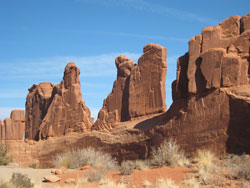 When early explorers gazed at the sheer walled, gigantic formations that encased a dramatic, narrow canyon in what is now Arches National Park, they must have been amazed with the magnitude of what they saw. Somehow these gigantic “sandstone skyscrapers” reminded them of the New York City skyline and so it became known as Park Avenue – an easy one-mile walk filled with a distinctive display of massive sandstone walls, fins, balanced rocks and monoliths. When early explorers gazed at the sheer walled, gigantic formations that encased a dramatic, narrow canyon in what is now Arches National Park, they must have been amazed with the magnitude of what they saw. Somehow these gigantic “sandstone skyscrapers” reminded them of the New York City skyline and so it became known as Park Avenue – an easy one-mile walk filled with a distinctive display of massive sandstone walls, fins, balanced rocks and monoliths.
The geological history of this amazing scenery began more than 150 million years ago - - way back when the original rocks started breaking down into smaller and smaller pieces. Then the big movers took over - wind and water. The larger, heavier fragments dropped closer to their source, while the smaller, lighter ones were carried far away from their home base. The shifting sands piled up - one layer on top of another until the weight of the upper, younger layers compacted the older, lower ones. Minerals within the ground water acted like glue and the cemented sand turned into stone. Eventually the tremendous pressure from above, fractured the rocks below. Then erosion ever so slowly exposed the hidden structures leaving behind the impressive landscapes that we have today.
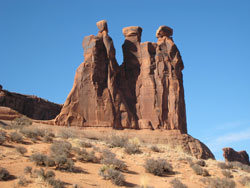 From Moab, it’s a quick, straightforward drive to see the marvelous “skyscrapers” that tower above Park Avenue. From the center of town, go north on Highway 191 for three miles to the entrance station of Arches National Park. The trailhead, one of the first major stops in the park, is just 2.5 miles after the entrance station. From Moab, it’s a quick, straightforward drive to see the marvelous “skyscrapers” that tower above Park Avenue. From the center of town, go north on Highway 191 for three miles to the entrance station of Arches National Park. The trailhead, one of the first major stops in the park, is just 2.5 miles after the entrance station.
The sheer walls along the Park Avenue Trail are made up of three layers of rock. The very top and youngest layer is the Moab Member of the Curtis Formation. Deposited as dunes on a beach, it is a light colored sandstone, most of which has been eroded away. It can also be found on the top of Delicate Arch and in the upper layers of Fiery Furnace.
The middle section consists of the finely grained Entrada Sandstone, which is a dominant cliff builder and arch former. Over the past two million years, the cracks in that sandstone layer has eroded away to fins, which are the vertical rock slabs that gave the original impression of skyscrapers.
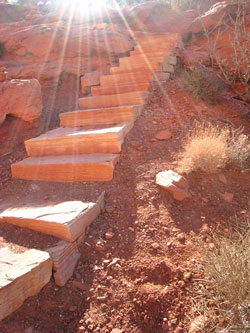 The Dewey Bridge Member of the Carmel Formation, the oldest layer at the bottom, has a muddy looking, reddish-brown color. This lumpy, contorted rock is what remains from a tidal flat environment. Since it is softer than the above layers, it erodes more quickly. The Dewey Bridge Member of the Carmel Formation, the oldest layer at the bottom, has a muddy looking, reddish-brown color. This lumpy, contorted rock is what remains from a tidal flat environment. Since it is softer than the above layers, it erodes more quickly.
From the Park Avenue trailhead, it is an easy downhill walk all the way to the Courthouse Towers parking area. By arranging a pick-up, you can avoid the uphill walk back up the trail. The National Park Service recommends that hikers walking both directions retrace their steps on the trail, rather than walk back along the road. I like walking both directions so that I can get a different perspective each way.
A concrete sidewalk goes from the Park Avenue trailhead to an overlook with a sign that explains the geology of this intriguing canyon. The trail then proceeds sharply down a stone staircase to a rocky, sandy wash. The well-marked route (just follow the piles of rocks) from there wanders through a wonderland of massive sandstone figures with wildly imaginative names. Popsicle Rock, Queen Nefertiti, Queen Victoria, Sausage Rock, The Three Gossips, The Organ, Courthouse Towers and the Tower of Babel all conjure up strange scenes from an ancient fairy tale.
Towards the lower end of the trail, a series of small potholes have been eroded out of a wide section of the slickrock. When heavy rain fills them up, the race is on for various aquatic species to complete their life cycle before the pools dry up again. The eggs of the fairy shrimp are viable without any moisture for several years and when they do get immersed in a miraculous deluge of water, hatching occurs within 30 hours. For the red-spotted toad, the rush is on to mate so the female can lay her eggs as quickly as possible. Within a few hours tadpoles emerge from those eggs, and if the water lasts for the next vital 40 to 60 days, the survivors become adults.
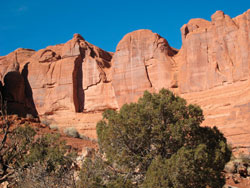 When the trail ends, an obvious arrow indicates the way across the road to the Courthouse Towers parking area where Baby Arch is visible, just to the right of The Three Gossips. Still an infant, Baby Arch is a very small hole in a very large rock. When the water dissolves the natural cement (calcium carbonate) that hole will get bigger and bigger until it runs its course as an arch and collapses. That is probably what happened to Sheep Rock. The sharp cleavage on Sheep Rock, which is to the right of Baby Arch, is a good indication that it used to contain arches that extended to another nearby rock face. When the trail ends, an obvious arrow indicates the way across the road to the Courthouse Towers parking area where Baby Arch is visible, just to the right of The Three Gossips. Still an infant, Baby Arch is a very small hole in a very large rock. When the water dissolves the natural cement (calcium carbonate) that hole will get bigger and bigger until it runs its course as an arch and collapses. That is probably what happened to Sheep Rock. The sharp cleavage on Sheep Rock, which is to the right of Baby Arch, is a good indication that it used to contain arches that extended to another nearby rock face.
Like the early explorers I was amazed when I saw the powerful showcase of rock formations in Park Avenue. Fascinated with the scenery and geology of this incredible canyon, I stopped often to look at the magical stone “skyscrapers” that seemed to stretch up to the sky. This trail can easily be done in an hour, but a show this spectacular shouldn’t be rushed.
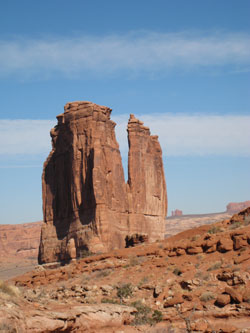
|
Biological Soil Crust (aka)
Cryptos (krip’ tose):
The surface of
Moab’s desert is held
together by a thin skin of living organisms known as cryptobiotic
soil or cryptos. It has a lumpy black appearance, is very
fragile, and takes decades to heal when it has been damaged.
This soil is a critical part of the survival of the desert.
The cryptobiotic organisms help to stabilize the soil, hold
moisture, and provide protection for germination of the seeds
of other plants. Without it the dry areas of the west would
be much different. Although some disturbance is normal and
helps the soil to capture moisture, excessive disturbance
by hooves, bicycle tires and hiking boots has been shown
to destroy the cryptobiotic organisms and their contribution
to the soil. When you walk around Moab avoid crushing the
cryptos. Stay on trails, walk in washes, hop from stone to
stone. Whatever it takes, don’t crunch the cryptos
unless you absolutely have to! |
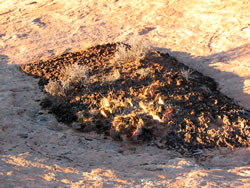
Cryptobiotic soil garden
|
|
|